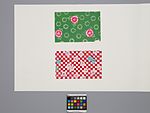chiyogami (Paper)
About this object
History of use
Papermaking originated on the Asian mainland and spread to Japan by around the 6th or 7th century. For centuries Japan has produced the greatest quantity and variety of handmade paper or washi (和紙). Traditionally, papermaking was a family or community enterprise which thrived in mountain farming communities where cold, pure water and wild bast fibre shrubs, such as mulberry, were plentiful. Washi is an important cultural symbol, as well as a significant aspect of both Shinto and Buddhist rites and customs. Chiyogami (千代紙) was originally produced as woodblock prints, and was likely first made in Kyoto. It was used for writing or poetry paper, for lining incense boxes, or for wrapping cosmetics. It is presently also used for Anesama (姉様) dolls, toys, artificial flowers and greeting cards. Although formerly an expensive luxury item used only by high-ranking individuals, chiyogami later became less expensive, and a popular gift for young women.
Narrative
Part of Vol. V (chiyogami-katazomegami); sample nos. 810-811; from Tesukiwashi Taikan (手漉和紙大鑑) published in Tokyo in 1973–1974, which features a collection of over 900 handmade papers. It was produced as a project to commemorate the centennial of Mainchi Newspapers and to preserve Japanese handmade paper. A collection on this scale had not been made before. This collection consists of 5 boxes of mounted and labelled samples with an explanatory book in 4 of the boxes. The text is in Japanese and with less detail, in English. Compiled and edited by a special editorial staff of scholars. Published by the Mainchi Newspapers, Tokyo, Japan.
Cultural context
Chiyogami (千代紙) made in Tokyo is called Edo chiyogami (江戸千代紙) and chiyogami made in Kyoto is known as Kyō chiyogami (京千代紙). This collection features Edo chiyogami by Hirose Tatsugorō IV (広瀬辰五郎四代目), the fourth generation of Isetatsu (いせ辰), a shop established in 1864 in Tokyo (formally known as Edo 江戸), which specializes in Edo chiyogami and Omocha-e (おもちゃ絵/玩具絵) (“play prints”).
Iconographic meaning
The patterns are called Kemaru (毛丸) and Ichimatsuzakura (市松桜). Sample 810 represents the dance 'Shishimai' with festive peonies in full bloom and pinwheels representing lion manes. The checkerboard pattern of 811 is named after the kabuki actor Ichimatsu Sanogawa, a female impersonator who used it for his stage costume. Many kimono and obi (sashes) were in this pattern when it was a favourite for young women.
Specific techniques
Washi (和紙) sample. Pigment is applied to a cherry wood block, then the paper is applied and rubbed using a baren (a disk-like hand tool used to burnish the back of a sheet of paper in order to lift the ink from the block).
Physical description
Washi samples mounted horizontally on white, labelled and folded paper with three-pointed leaf above scrolled 'M' watermark. Two rectangular multi-coloured woodblock print samples. The top sample (810) has three six petalled white with bright pink and red flowers, on a green ground. Outlines of leaves for three flowers and for the many pinwheels which cover the remaining ground are white. White border on bottom and right. Bottom sample (811) has small red and white checkerboard ground with ten petalled pink with yellow and blue or blue with yellow and green flowers; small five petalled green flowers between.Black line at inside border on right and slightly wider border at bottom. Mounting paper folds over part of sample from right.
Categories
Materials
